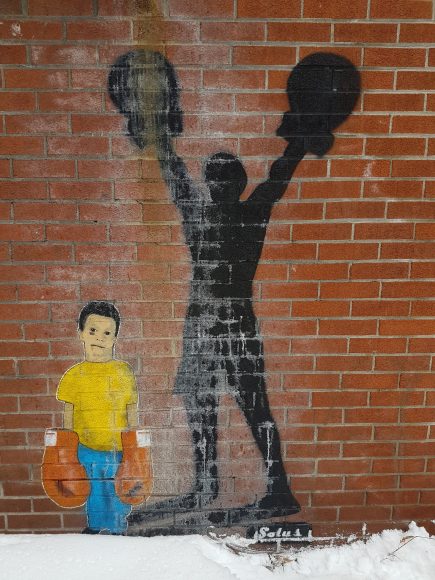Balance
The balancing organs of our inner ear are an integral part of what lets us function in the world around us. Yet our sense of motion is not something that drifts into our conscious awareness when these organs are normally at work. Strikingly, when there is something wrong with this system (ask anyone who has suffered from dizziness), we become sickeningly sensitive to the slightest movement – completely off-balance when performing the simplest of tasks. Stability, in the most literal sense, is crucial for us to be able to function normally in our daily lives; without it, we might fall over even when standing still.
An expectation of stability is also crucial for us to stay upright. If you’ve ever been disoriented as to who is moving, when sitting in one train and staring at another moving beside you, or felt a little off-kilter when staring at a shifting scene on a giant screen, you’ve felt this disconnect between expectation and reality – an expectation of a stable reference point.
The same is true when navigating other aspects of our lives, when navigating the basic needs that some may take for granted. If the walkway you are navigating is constantly shrinking, leaving you precariously teetering on the edge, balancing to stay upright, the effort and energy you expend will eventually exhaust you. Chronic stress, the type felt when living in an unstable world, will exhaust you. Stability and an expectation of stability are crucial to living a happy and healthy life.
Precarious and the Precariat
The theme for this issue of Montréal Serai is “Precarious.” As mentioned in our call for submissions, many of Montréal Serai’s friends and subscribers find themselves in a precarious state. Once employed full-time, now working part-time or on contract work with no social coverage – and no bargaining rights. These precarious times have given rise to the precariat, a social class formed by people suffering from precarity. The word is a portmanteau of proletariat and precarious. It is an unpredictable state, defined by insecurity and lack of continuity. We at Montréal Serai are overwhelmed by the response to our call – a response by writers, artists, poets and performers, sharing their experiences, at times highly personal, within this new state of the world.
In this issue
Máire B. Noonan, Anne Cimon and Nilanjan Dutta take us through their own, at times crushingly intimate, twists and turns within precarity. In “Resist Definition,” Noonan speaks of always having resisted defining herself as something, such as a person living with illness; although she is following the path of many in the academic precariat, she does not let it designate who she is. In “A Food Bank Time,” Cimon talks of another type of resistance, against the acceptance of the reality of her situation: “One day, I had to face the fact that there were no more options, and even borrowing on the future was no longer viable.” Dutta, in “Jaywalk on Razor’s Edge,” wonders “who coined the word ‘freelancer.’ I am free, without a lance. My life is no longer like I used to know it. Precarity has overtaken security.”
Two artists give us different takes on those living on the edge. Julian Samuel’s immersive abstract paintings were “initially inspired by increasing signs of intolerance towards minorities in Québec.” Oleg Dergachov’s evocative illustrations and cartoons explore different facets of the notion of “Precarious.”
In “The Precariat and Canada’s Poverty Problem,” Laura Neidhart’s extensive experience while working with the precariat shines a light on both causes and solutions for this state of precarity, while exposing the fallacies behind the notion that precarious employment answers a “demand for flexibility on the part of employees.” She states that “under international human rights law, people in Canada have a right to fair and paid work, a right to earn their living by work which is freely chosen, and a right to experience just and favourable conditions during employment. Reciprocally, governments in Canada have a legal obligation to meet and fulfill this right…. The shift in this conversation from one exclusively of market and economic growth to one of rights is essential.”
Montréal Serai’s own Maya Khankhoje and Rana Bose provide more insights on the life precarious. Khankhoje reviews The Precariat. The New Dangerous Class, whose “author calls for revisiting the trinity of liberty, equality and fraternity in developing a progressive agenda with the precariat in mind.” In “Theodolites, Rights and Democracy,” Bose is struck with a revelation while staring at his painstakingly right-angle-engineered neighbourhood (engineered with the aid of the engineer’s tool for straight lines – the theodolite). In this “unending straightness,” he sees “a master plan based on a certain consensus” and asks “What is the philosophy of democracy in pre-industrial, industrial and post-industrial societies?” He posits that “those who were born in a rectilinear, theodolite-controlled democracy have a somewhat aloof but superior sense of human rights and responsibilities…. Because here, the other issues of social development like colonial displacement, feudal land control and sharecropping, easy access to public toilettes, warehousing and food distribution, clean air and water for our children, comfortable public transportation, education that does not blatantly discriminate based on tribe, caste and skin colour, and sewage and garbage-disposal systems that work mostly in a clockwork manner have all facilitated a sense of uniform calm and order.”
With “On the Certainty of Uncertainty,” Michael Bristol elegantly contrasts the late 19th-century lives of subsistence farmer, Manuel Valadão, and industrial tycoon, John. D. Rockefeller. While noting that “uncertainty for most people basically had always meant the heartache and the thousand natural shocks that flesh is heir to,” Bristol emphasizes that “[w]hat people actually need is sustenance, physical well-being, peace of mind, a pathway (not just a purely abstract ‘opportunity,’ mind you) to the full realization of their capabilities and their gifts.”
Two prose pieces, Sharon Bourke’s “Imaginings” and Dorota Anna Kozinska’s “Sleep” have protagonists coping with the shifting and unstable world around them. Bourke’s lucid “imagining” conjures a widow of war who “manage[s] with almost nothing. Rather than travel a long distance looking for handouts of food that might or might not be distributed to the ‘internally displaced,’ she rummage[s] through the cupboards in abandoned houses, turning meager crumbs into a meal for the day, and wetting her lips with water captured from drain pipes.” Kozinska puts forth Sleep as the brother of Death. Her protagonist cannot sleep. “Not since the wall went up and the gates closed with a protracted metallic groan.” We vividly witness his anguish and torture as he yearns for a time before his normalcy was uprooted. “Everything had changed but the black birds remained the same, perhaps, he thought, because they still flew over the wall and visited the old life that J. was certain existed behind it, but which for some unknown reason he was forbidden to see.”
In this issue, we also have four more reviews. Julian Samuel presents us with his own surrealistically informed review of the film Icaros: A Vision. “On the face of it, [the film] brings together two pathologies, a shaman’s developing blindness and a rich Westerner’s spreading cancer. Both the blindness and the cancer will be victorious, in spite of a healing forest.” Continuing on the theme of loss, Marie Thérèse Blanc reviews a Fringe production of the play Mapping Grief. “On the face of it, the [the myth of Orpheus and Eurydice] seems to suggest that nothing’s for certain: here today, gone tomorrow…. In Mapping Grief, Gina Granter explores a real-life tale of young loss…. [Inspired by James Joyce] the story is tensely anachronological rather than comfortably linear.” Maya Khankhoje reviews the novel American Candide as “a welcome revival of the picaresque novel best represented by Cervantes’ Don Quixote and Voltaire’s Candide. If you’ve read the original Candide, you will be delighted with this modern-day version.” Finally, we have a review by Aliya Varma of the collection of essays, Too Much and Not the Mood. In her personally connected review, Varma offers that “the essays are like short journeys; they evoke the same sense of excitement that you feel when discovering a new place.” In this collection, author Durga Chew-Bose conjures her own childhood impression of precariousness. In describing a painting by Jean-Léon Gérôme, she relates that “the Snake Charmer’s whole scene looked precarious because it didn’t seem like a painting but a photograph. Rarely does a subject disturb me as much as when it slopes my ability to discern what’s real and what isn’t.” In the times we live in, others can no doubt relate to the disruptive feeling of things “true” and “fake” colliding and mingling effortlessly and intentionally – a precarious feeling indeed. We hope that all these thought-provoking pieces will provide some sense of stability to our readers in unstable times.

Jean-Léon Gérôme, The Snake Charmer, Sterling and Francine Clark Art Institute (circa 1879). Public domain.












